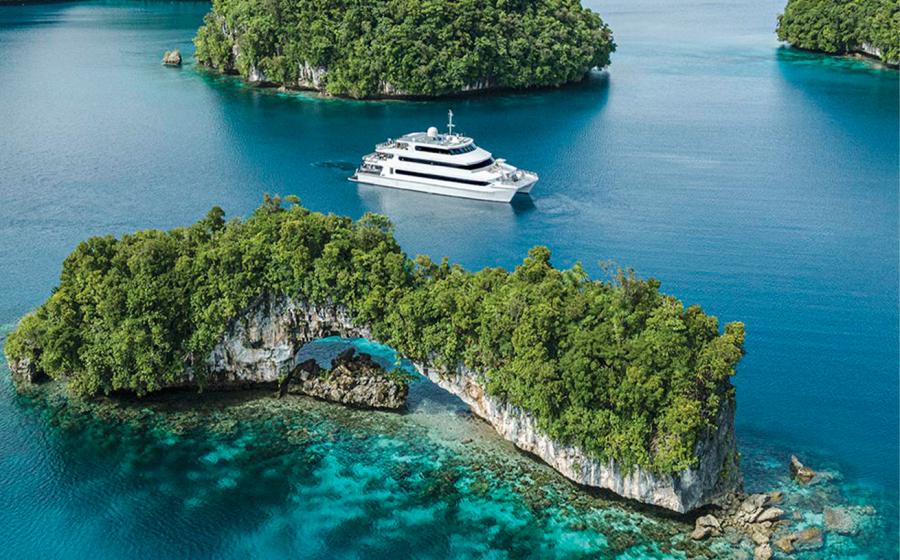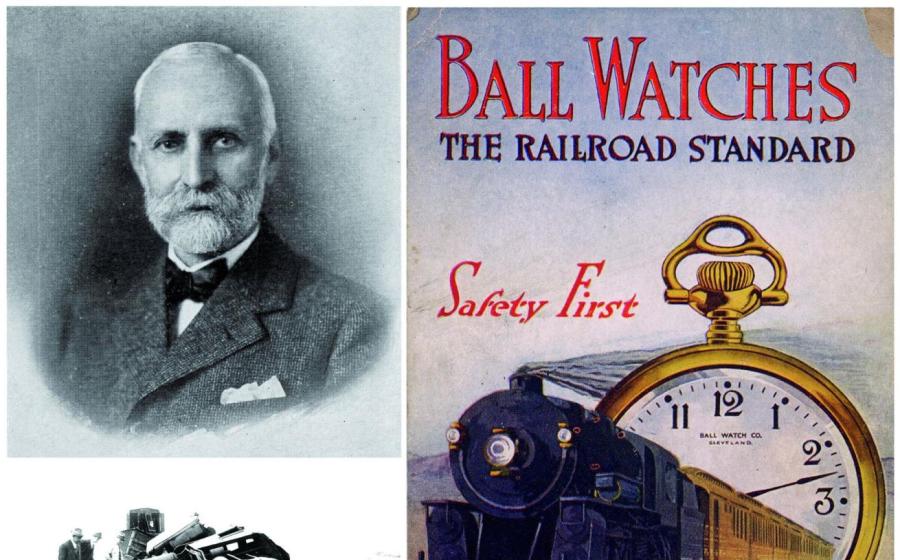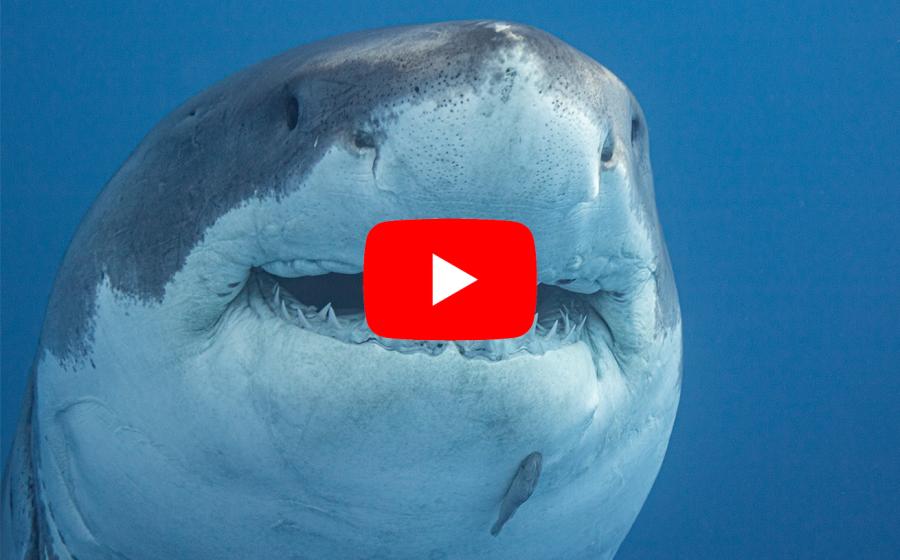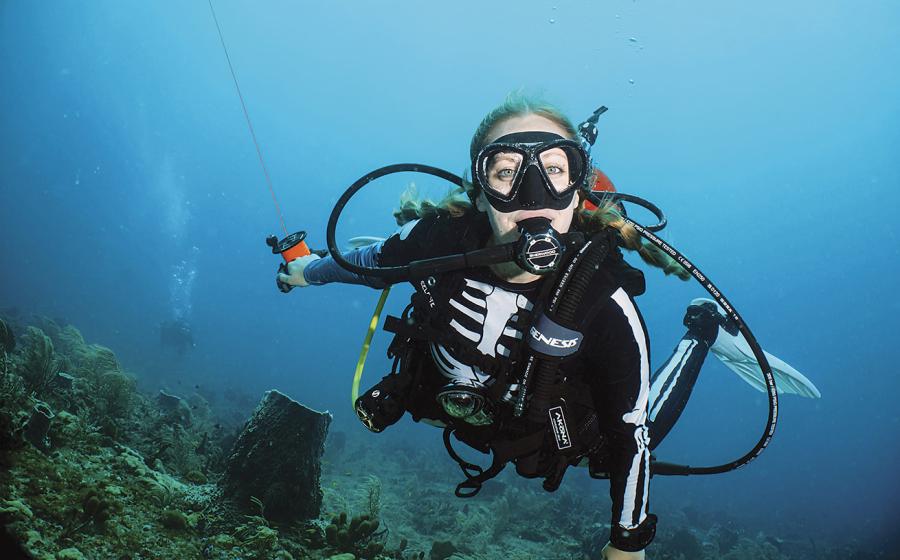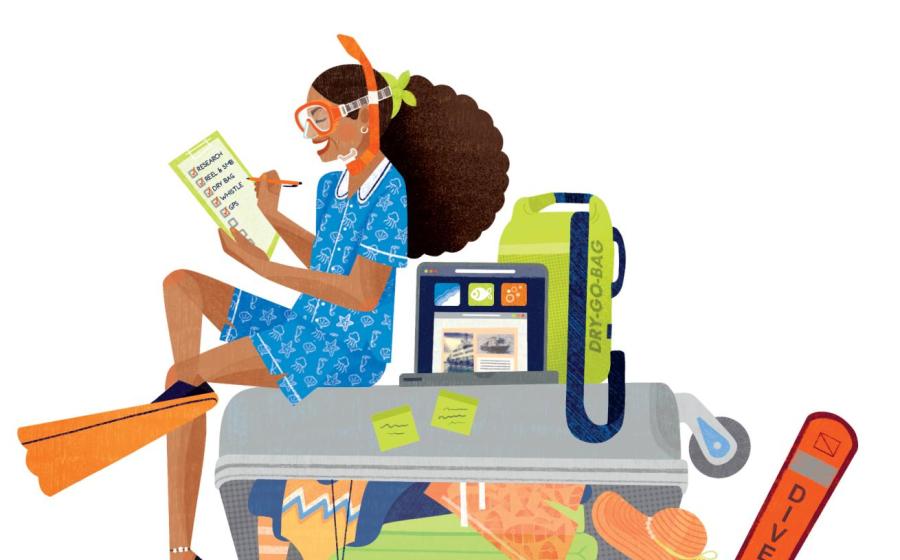Divers Behaving Badly: What Not To Do Underwater
I recently returned from my first trip to Palau. The diving was great — lots of schooling fish, a healthy population of sharks, friendly Napoleon Wrasse, the surreal Jellyfish Lake, Blue Corner (arguably one of the top dives in the world), and lovely reef structure, including some big beautiful blue holes. That was all good, and I plan to share a gallery and write up next month about this very popular dive destination.
Unfortunately Palau, having become such a popular divers’ mecca, is apparently starting to suffer from too much diver pressure. If all divers were consistently careful about the beautiful reefs, and the animals that inhabit them, the situation would not be of such great concern. But herein lies the rub — there appear to be a significant population of international divers visiting Palau who are either clueless or careless about their dive practices, and there is reef damage that mirrors this reality.
In all of my travels, I have never seen as much blatant coral touching and reef abuse as I saw in my 30 or so dives in Palau. Nor have I seen as much poor buoyancy control.
Seeing hoards of divers literally crawling all over the corals, with apparently not a care or concern for the health of the very fragile and delicate colonies of these creatures, plus some mishandling and harassment of animals, was very disheartening. Palau currently allows divers to wear gloves while diving. I believe this to be a very bad policy, as it appears that the many divers wearing gloves feel free to paw the reefs, grab onto sponges and corals, and handle wildlife — with zero consequence. Other popular dive destinations, including Cozumel, have banned gloves, for exactly this reason.
All divers make mistakes and inadvertently contact the reef from time to time. Photographers like myself must be particularly careful, as when we have our eyes in our viewfinders, we tend to lose a sense of where we are in relation to the reef. For this reason, I use a muck stick (an 18-inch-long narrow metal rod) when I take photos, especially of anything up close (macro), as I can place the small tip of the stick on a bit of sand, rock, or dead coral, and use the stick to keep the camera and me balanced and up off the reef or away from a wall. I also make no sudden movements when close to the reef, and so, in the unusual event of a touch down, I can use my breath (or inflate my BC a bit) to lift myself off, rather than whacking with my fins, or using my hands or elbows to push off.
I saw armies of amateur photographers in Palau (some of whom were carrying more than one camera), and most of them were not using muck sticks. Instead, I witnessed a lot of (gloved) coral holds, touch downs and coral kicking with fins, and in way too many cases, full body layouts on the corals. One guy I watched had a big DSLR rig (like mine) and a smaller hand held digicam. He had the big camera set up for wide angle, and the smaller camera was presumably for taking fish portraits, macro subjects and video. Every time he went to use the small camera, he dropped the big heavy set up onto the coral! I was shocked that the divemaster wrangling his group did not correct this behavior — this fellow was diving off a liveaboard, and when I saw this behavior, it was at the end of his 5 1/2 days of diving. In fact, from what we could see, the entire group of divers on this boat were reef crawlers. An opportunity was lost to help to educate these people and make them better divers.
I also watched a pair of divers from our day boat stand on corals, maul the Japanese Jakes seaplane wreck (including picking up and moving artifacts — not a good idea as apparently some of this stuff is still live, unstable ammunition), and generally display appalling buoyancy control (fin whacking corals, sea fans, etc). The dive guide did nothing to correct this — in my mind a very big omission.
So here is the thing — it would seem wise for all dive operations and their dive masters and guides, all over the world, to thoroughly brief their guests before the dive with instructions regarding good buoyancy control, no touching, no harassing, limiting photos of sensitive subjects, and other photo and dive etiquette — such as sharing photo opportunities that are found by the dive guide (including letting the non-photogs have a gander), and not chasing animals into the blue. Add to that, not crowding or landing on someone taking a photo, and not elbowing someone out of the way to get a shot (as happened to me in Palau!).
And these problems are not unique to Palau, it is just that there is a larger concentration of divers there than anywhere else I have been diving, perhaps with the exception of Cozumel. In Cozumel, there is much more attention being paid to good dive practices, including no touching. There is still work to be done with inexperienced divers and their correct weighting and buoyancy control, but generally speaking, there is better awareness and mentoring happening there, and the banning of gloves no doubt has helped immensely.
Guides/Divemasters need to follow through when they see the divers under their watch doing something that is potentially harmful to the reef, to its denizens, to themselves, or to other divers. This can be done in an informational, non-threatening, but firm way. Dive guides’ livelihood not only depends on tips, but on the long term health of the reefs they dive and show to others. Being an ambassador for the ocean, and being an example (and instructor) of excellent dive practices should be essential to folks who do this job.
When I decided to write this controversial column, I reached out to my Facebook friends to ask them to share some of their stories about “bad divers” they’ve seen. Several had stories of seeing divers deliberately doing harmful things: climbing on walls (corals and sponges) to take pictures of themselves with selfie sticks; harassing eels and pufferfish (both with injurious consequences); photographers standing on healthy corals in the shallows to get over/under shots; a diver manhandling live ammunition (to his, and anyone near him, peril); divers riding turtles and manta rays; and divers tossing sting rays like frisbees.
Even more serious, some had stories of divers not looking before leaping off boats, docks etc., and landing on other divers (again, with some serious injurious outcomes — metal tanks and skulls are not a good match). There were also tales of divers being careless with their buoyancy and fins and silting up swim throughs, caverns, wrecks and caves, so that divers behind them could become completely disoriented and unable to find their way out. The list of no-no’s goes on…
Divers who dunk their masks, wetsuits and sandy sandals (!) in the clearly marked camera rinse tank. Divers who don’t rinse their urine-saturated wetsuit before hanging it snugged up against someone else’s. Touching other people’s gear. Moving other people’s gear. Taking someone’s second tank while they are still in the water because it has a better fill than yours. Silting up someone’s photo op with poor buoyancy or finning technique. Spreading one’s gear all over the boat — which creates tripping hazards and confusion. There was even a story of a diver barfing in someone else’s dive bag, then zipping it up and leaving it for the diver to find later! Speaking of barfing — it happens to some unfortunate souls, and the right thing to do is to go to the back corner of the boat, on the lee side (so wind is blowing away and not into the boat), and spew into the water from there.
Add to the list of bad behaviors: people who talk during dive briefings (both rude and potentially a problem as they will not know the dive plan nor the safety guidelines), people who don’t tuck up their hoses and gauges so that they drag and bump along the bottom, damaging the reef as they go, and people who jump the line of people waiting to either enter or exit the water.
It isn’t hard to do the right thing. It will require more dive professionals who take their job seriously and not only herd people, but educate them and inspire them to become better divers. It also takes dive instructors planting the seeds early on about good dive etiquette and behavior.
Divers who witness dangerous or harmful behavior should let dive personnel know so that they can follow up with the perpetrators. There are ops out there that will banish divers from their boats if they refuse to be respectful of the reef or other divers. I think we need more of this hard line approach.
And it will take more divers who come to understand the importance of being part of a community that cares about the health of the ocean, and each other, and who understand the amazing privilege we have to live in a time when touring under the surface in the otherworldly ocean is so easy and available.
The pictures I am sharing are from just two dives in Palau, when I happened to be shooting wide angles and so could photograph some bad diving practices. I saw these kinds of behaviors on every dive on this trip.
Judy G is a traveling underwater photographer. Check out her blog HERE and follow her on Facebook: Judy G Diver
More Scuba Diving Blogs from Judy G
Meet the Woman Behind the Lens
I recently returned from my first trip to Palau. The diving was great — lots of schooling fish, a healthy population of sharks, friendly Napoleon Wrasse, the surreal Jellyfish Lake, Blue Corner (arguably one of the top dives in the world), and lovely reef structure, including some big beautiful blue holes. That was all good, and I plan to share a gallery and write up next month about this very popular dive destination.
Unfortunately Palau, having become such a popular divers’ mecca, is apparently starting to suffer from too much diver pressure. If all divers were consistently careful about the beautiful reefs, and the animals that inhabit them, the situation would not be of such great concern. But herein lies the rub — there appear to be a significant population of international divers visiting Palau who are either clueless or careless about their dive practices, and there is reef damage that mirrors this reality.
In all of my travels, I have never seen as much blatant coral touching and reef abuse as I saw in my 30 or so dives in Palau. Nor have I seen as much poor buoyancy control.
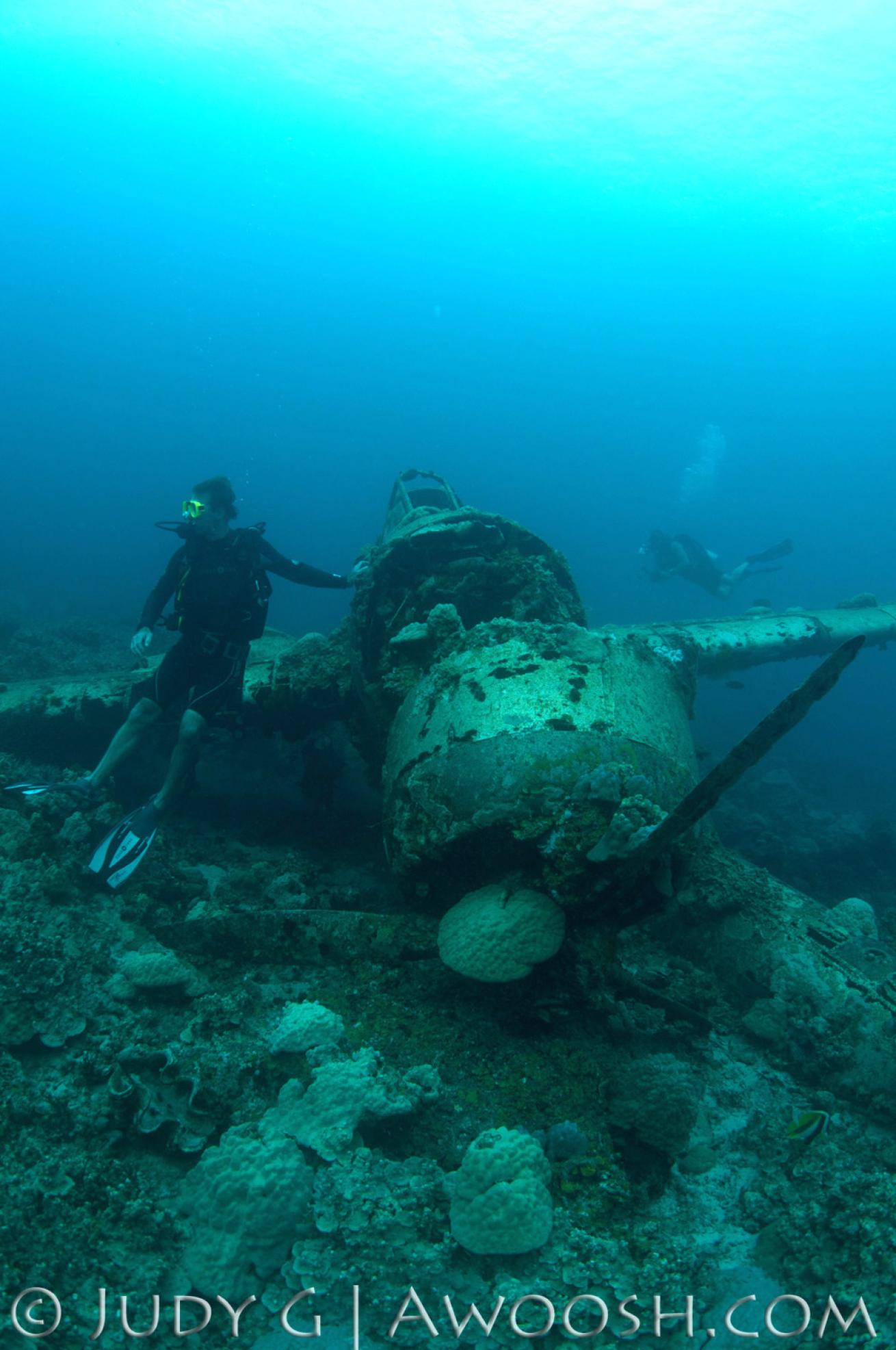
Judy GDiver on the Japanese Jakes Seaplane, Palau
A couple of major infractions here by the diver in the photo: standing on the coral, and touching the wreck. This same diver was also spotted lifting artifacts off the sea floor around the wreck, handling them, and moving them around. In addition to the danger (some of the artifacts could have been live, unstable ammunition), messing with historical sites like this is very frowned upon by the diving community.
Seeing hoards of divers literally crawling all over the corals, with apparently not a care or concern for the health of the very fragile and delicate colonies of these creatures, plus some mishandling and harassment of animals, was very disheartening. Palau currently allows divers to wear gloves while diving. I believe this to be a very bad policy, as it appears that the many divers wearing gloves feel free to paw the reefs, grab onto sponges and corals, and handle wildlife — with zero consequence. Other popular dive destinations, including Cozumel, have banned gloves, for exactly this reason.
All divers make mistakes and inadvertently contact the reef from time to time. Photographers like myself must be particularly careful, as when we have our eyes in our viewfinders, we tend to lose a sense of where we are in relation to the reef. For this reason, I use a muck stick (an 18-inch-long narrow metal rod) when I take photos, especially of anything up close (macro), as I can place the small tip of the stick on a bit of sand, rock, or dead coral, and use the stick to keep the camera and me balanced and up off the reef or away from a wall. I also make no sudden movements when close to the reef, and so, in the unusual event of a touch down, I can use my breath (or inflate my BC a bit) to lift myself off, rather than whacking with my fins, or using my hands or elbows to push off.
I saw armies of amateur photographers in Palau (some of whom were carrying more than one camera), and most of them were not using muck sticks. Instead, I witnessed a lot of (gloved) coral holds, touch downs and coral kicking with fins, and in way too many cases, full body layouts on the corals. One guy I watched had a big DSLR rig (like mine) and a smaller hand held digicam. He had the big camera set up for wide angle, and the smaller camera was presumably for taking fish portraits, macro subjects and video. Every time he went to use the small camera, he dropped the big heavy set up onto the coral! I was shocked that the divemaster wrangling his group did not correct this behavior — this fellow was diving off a liveaboard, and when I saw this behavior, it was at the end of his 5 1/2 days of diving. In fact, from what we could see, the entire group of divers on this boat were reef crawlers. An opportunity was lost to help to educate these people and make them better divers.
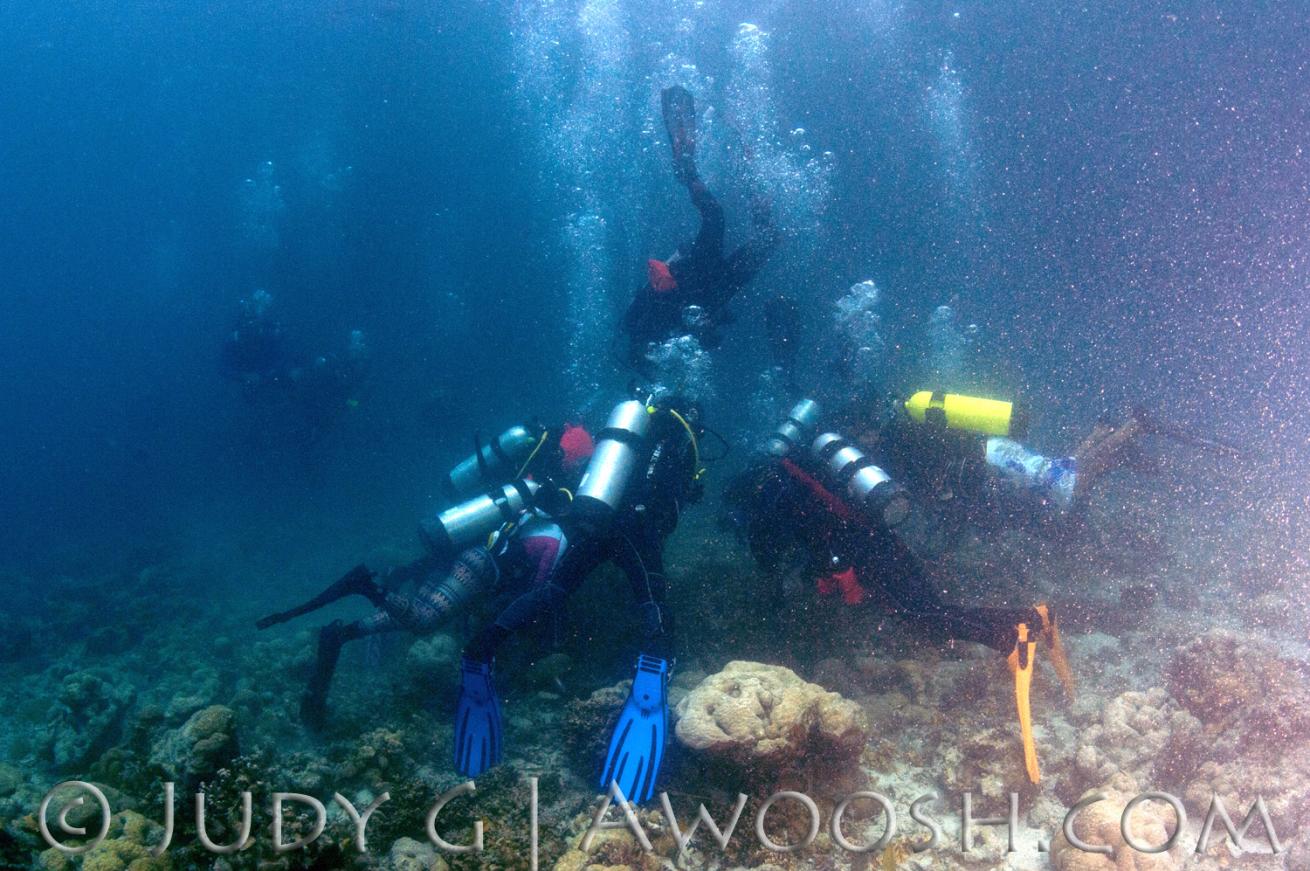
Judy GDives on the Bottom
I never did figure out what this group was looking at, but every diver in this large group was kneeling on the corals and using (gloved) hands to hold onto the coral, with the exception of the dive guide (yellow tank). These divers should instead be working on their buoyancy control so that they can hover over the coral rather than perch on it. Additionally, with so many divers touching down, the visibility for many meters around this group was totally stirred up by the silt clouds they generated. I was very disappointed that the dive guide was not correcting this behavior.
I also watched a pair of divers from our day boat stand on corals, maul the Japanese Jakes seaplane wreck (including picking up and moving artifacts — not a good idea as apparently some of this stuff is still live, unstable ammunition), and generally display appalling buoyancy control (fin whacking corals, sea fans, etc). The dive guide did nothing to correct this — in my mind a very big omission.
So here is the thing — it would seem wise for all dive operations and their dive masters and guides, all over the world, to thoroughly brief their guests before the dive with instructions regarding good buoyancy control, no touching, no harassing, limiting photos of sensitive subjects, and other photo and dive etiquette — such as sharing photo opportunities that are found by the dive guide (including letting the non-photogs have a gander), and not chasing animals into the blue. Add to that, not crowding or landing on someone taking a photo, and not elbowing someone out of the way to get a shot (as happened to me in Palau!).
And these problems are not unique to Palau, it is just that there is a larger concentration of divers there than anywhere else I have been diving, perhaps with the exception of Cozumel. In Cozumel, there is much more attention being paid to good dive practices, including no touching. There is still work to be done with inexperienced divers and their correct weighting and buoyancy control, but generally speaking, there is better awareness and mentoring happening there, and the banning of gloves no doubt has helped immensely.
Guides/Divemasters need to follow through when they see the divers under their watch doing something that is potentially harmful to the reef, to its denizens, to themselves, or to other divers. This can be done in an informational, non-threatening, but firm way. Dive guides’ livelihood not only depends on tips, but on the long term health of the reefs they dive and show to others. Being an ambassador for the ocean, and being an example (and instructor) of excellent dive practices should be essential to folks who do this job.
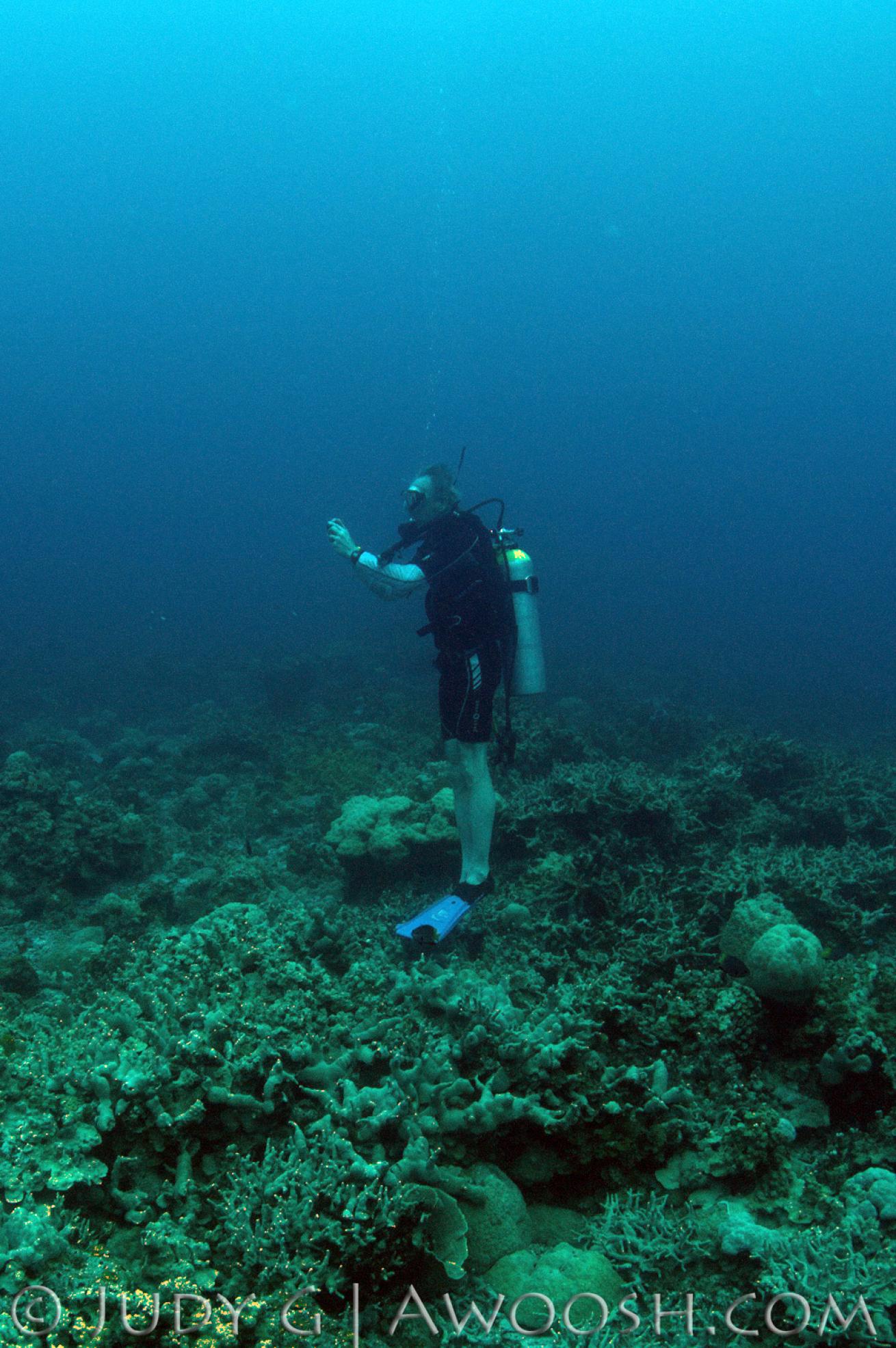
Judy GStanding on the Coral
This was pretty unbelievable — this diver clearly thought it was OK to touch down and stand on the corals to take his pictures. I saw him do this several times on during our three dives off a day boat. Again, the dive guide did nothing to correct this behavior.
When I decided to write this controversial column, I reached out to my Facebook friends to ask them to share some of their stories about “bad divers” they’ve seen. Several had stories of seeing divers deliberately doing harmful things: climbing on walls (corals and sponges) to take pictures of themselves with selfie sticks; harassing eels and pufferfish (both with injurious consequences); photographers standing on healthy corals in the shallows to get over/under shots; a diver manhandling live ammunition (to his, and anyone near him, peril); divers riding turtles and manta rays; and divers tossing sting rays like frisbees.
Even more serious, some had stories of divers not looking before leaping off boats, docks etc., and landing on other divers (again, with some serious injurious outcomes — metal tanks and skulls are not a good match). There were also tales of divers being careless with their buoyancy and fins and silting up swim throughs, caverns, wrecks and caves, so that divers behind them could become completely disoriented and unable to find their way out. The list of no-no’s goes on…
Divers who dunk their masks, wetsuits and sandy sandals (!) in the clearly marked camera rinse tank. Divers who don’t rinse their urine-saturated wetsuit before hanging it snugged up against someone else’s. Touching other people’s gear. Moving other people’s gear. Taking someone’s second tank while they are still in the water because it has a better fill than yours. Silting up someone’s photo op with poor buoyancy or finning technique. Spreading one’s gear all over the boat — which creates tripping hazards and confusion. There was even a story of a diver barfing in someone else’s dive bag, then zipping it up and leaving it for the diver to find later! Speaking of barfing — it happens to some unfortunate souls, and the right thing to do is to go to the back corner of the boat, on the lee side (so wind is blowing away and not into the boat), and spew into the water from there.
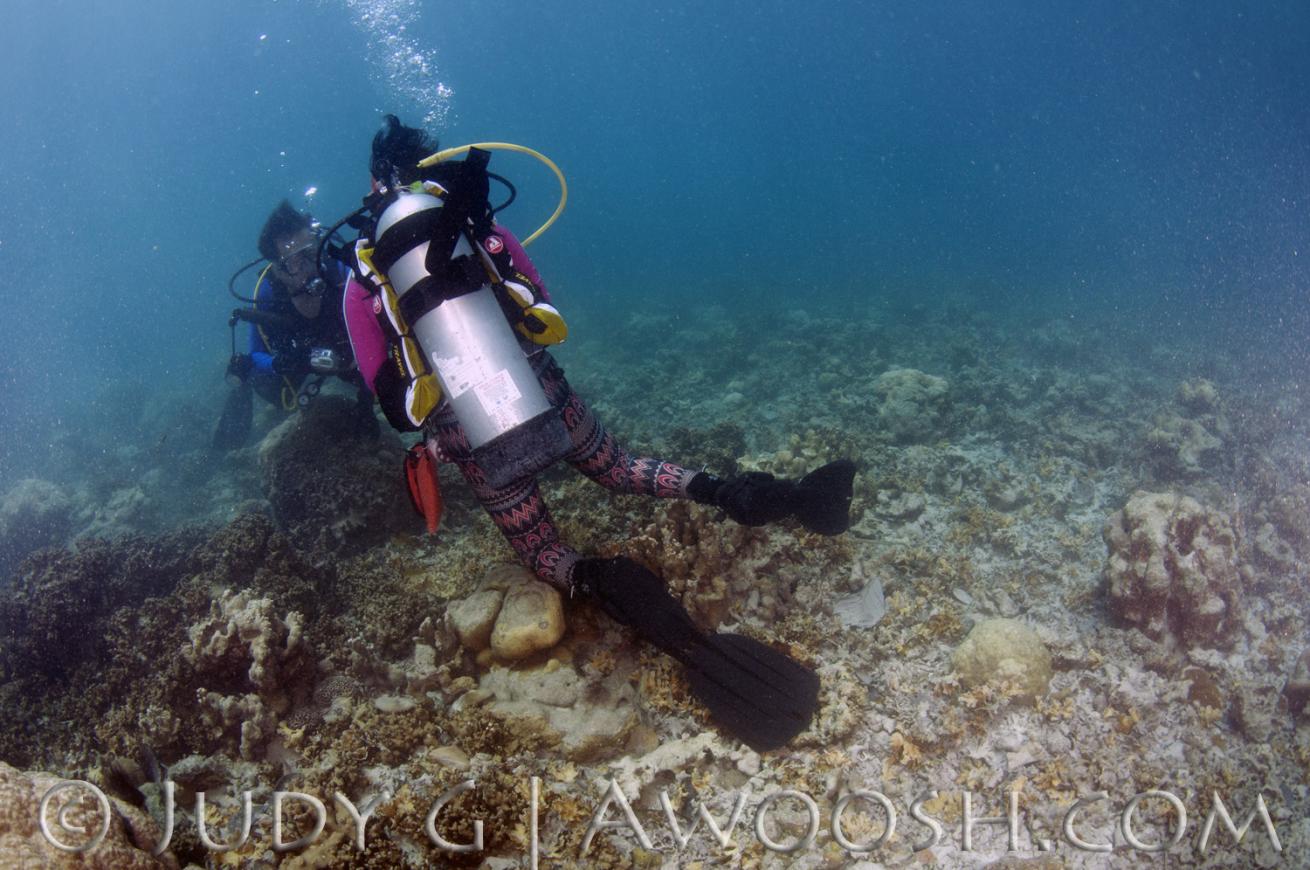
Judy GKneeling on the Coral
This pair of divers both had cameras. I watched for several minutes as they would find something they wanted to photograph, then they would both settle onto the coral to get their shots.
Add to the list of bad behaviors: people who talk during dive briefings (both rude and potentially a problem as they will not know the dive plan nor the safety guidelines), people who don’t tuck up their hoses and gauges so that they drag and bump along the bottom, damaging the reef as they go, and people who jump the line of people waiting to either enter or exit the water.
It isn’t hard to do the right thing. It will require more dive professionals who take their job seriously and not only herd people, but educate them and inspire them to become better divers. It also takes dive instructors planting the seeds early on about good dive etiquette and behavior.
Divers who witness dangerous or harmful behavior should let dive personnel know so that they can follow up with the perpetrators. There are ops out there that will banish divers from their boats if they refuse to be respectful of the reef or other divers. I think we need more of this hard line approach.
And it will take more divers who come to understand the importance of being part of a community that cares about the health of the ocean, and each other, and who understand the amazing privilege we have to live in a time when touring under the surface in the otherworldly ocean is so easy and available.
The pictures I am sharing are from just two dives in Palau, when I happened to be shooting wide angles and so could photograph some bad diving practices. I saw these kinds of behaviors on every dive on this trip.
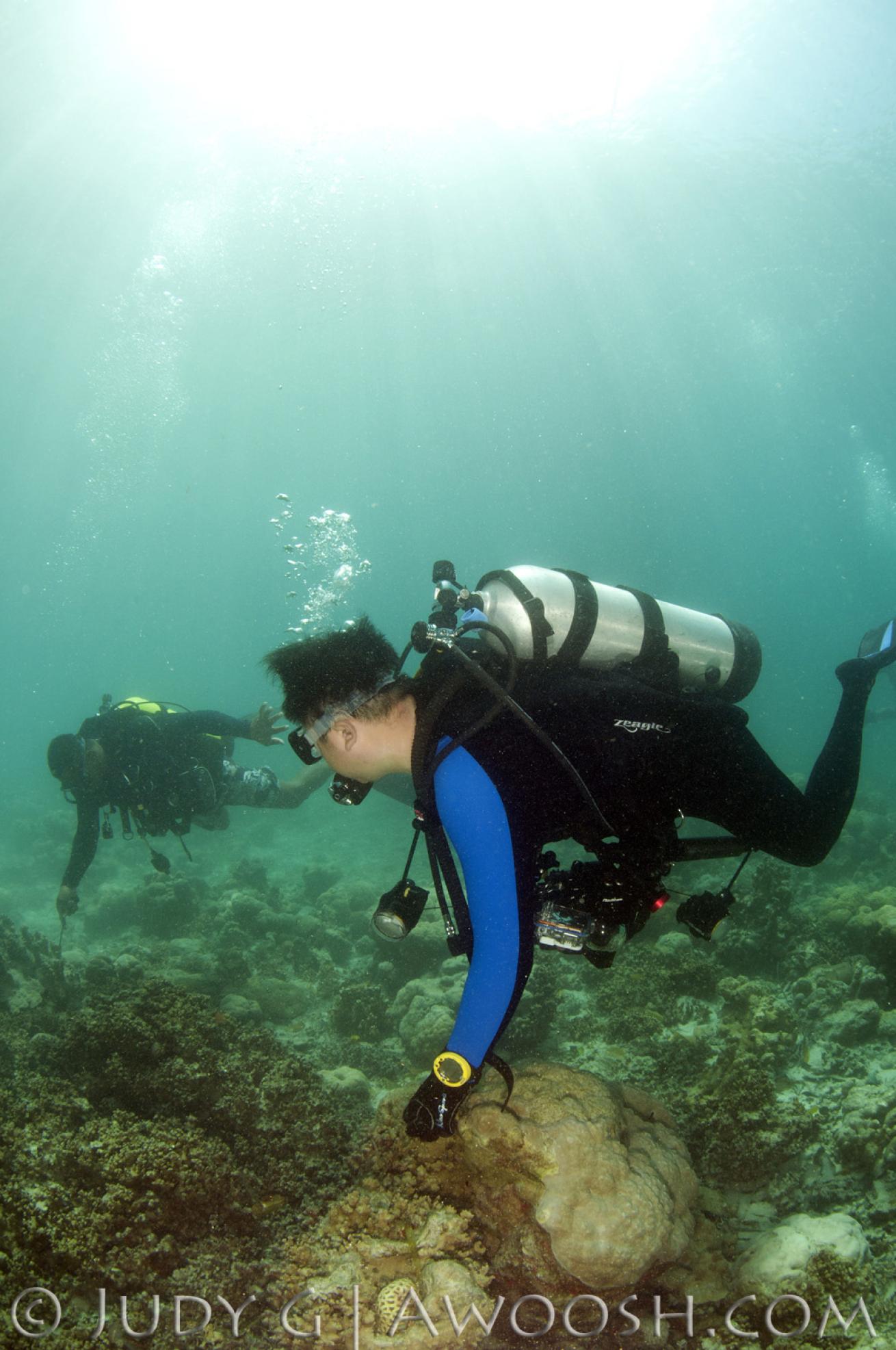
Judy GHandhold on the Coral
In the distance, you can see the dive guide (yellow tank) correctly using a muck stick to hold himself off the coral as he goes in for a closer look. The diver in the foreground instead uses his gloved hand to steady himself. I watched this same diver leapfrog from coral formation to coral formation by grabbing corals and hauling himself across the reef. Again, no correction from the dive guide.
Judy G is a traveling underwater photographer. Check out her blog HERE and follow her on Facebook: Judy G Diver
More Scuba Diving Blogs from Judy G
Meet the Woman Behind the Lens
BEFORE YOU JUMP IN, WATCH THIS:






